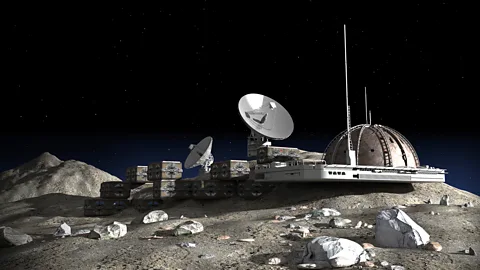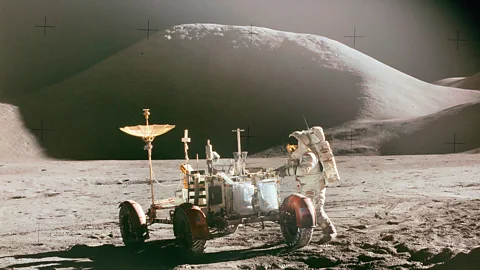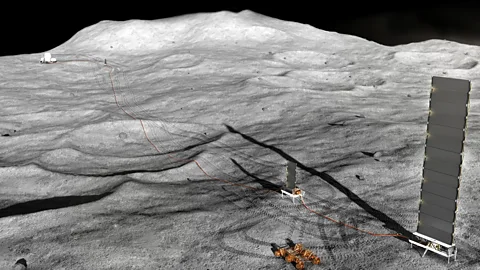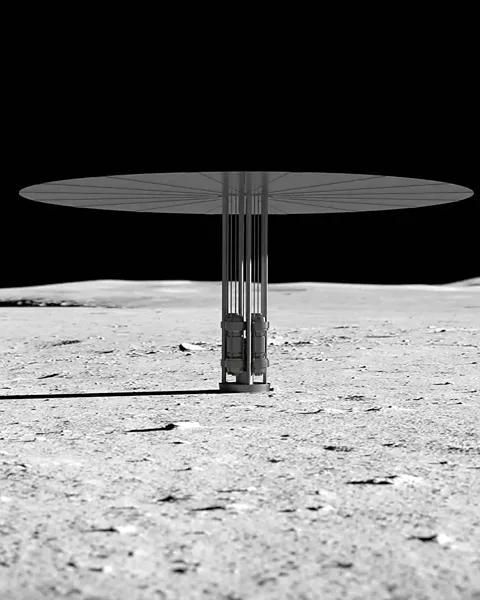From BBC World News
Edited by - Amal Udawatta
 Getty Images
Getty ImagesAstronauts living on the Moon will need lots of power – but they can't take fuel supplies with them. A new generation of miniature nuclear reactors could be the answer.
The 1970s TV series Space: 1999 began – like many a sci-fi drama – with a bang. A nuclear explosion tears the Moon out of Earth's orbit and sends Moonbase Alpha and its inhabitants on an exciting adventure through deep space.
It obviously left an impression on a young Elon Musk. In 2017, when envisioning SpaceX's plans for a future Moon base, he named it Alpha. Today, SpaceX is working with Nasa to return humankind to the Moon's surface as part of the US space agency's Artemis programme. The planned lunar outpost, however, has a more pragmatic working title: Artemis Base Camp.
Nasa and the US Department of State have issued combined guidelines for peaceful lunar exploration in the form of the Artemis Accords. So far 36 nations – including India, Japan, the UK, Canada, Australia, the United Arab Emirates and South Korea – have signed up.
China is also spearheading a base on the Moon with an equally practical title. The International Lunar Research Station, announced in 2021, currently has Russia, Belarus, Pakistan, Azerbaijan, Venezuela, Egypt and South Africa as signatories.
But whichever coalition builds the first base on the Moon, they will all need a reliable power source. Across the world many companies and space agencies have all come to the same conclusion.
"The truth is that nuclear is the only option to power a moonbase," says Simon Middleburgh from the Nuclear Futures Institute at Bangor University in Wales.
 Nasa
NasaA day on the Moon is not 24 hours, as on Earth, but a month. Or 29.5 days to be precise. There are effectively two weeks of daylight followed by two weeks of darkness, with temperatures reaching -130C (-202F). This is why the Apollo missions from 1969 to1972 all took place during a lunar day and close to the Moon's equator, when temperatures were manageable and prolonged sunlight could power scientific instruments and landers.
At the Moon's South Pole, where any base is most likely to be located, certain locations are illuminated by sunlight more than 80% of the time. But temperatures can drop even further in permanently shadowed craters where frozen water is likely to be found. This water will be needed not just to help keep astronauts alive, but also to produce fuel since there is no gas or oil on the Moon.
"Nuclear is the only game in town," says Middleburgh. "We can't take fuel up there. Solar panels won't work. Diesel generators won't work and the old-style radio-thermal generators just aren't big enough to pack a punch."
A radioisotope thermal generator was first used on the Moon in 1969, on Apollo 11, using heat generated by the decay of radioactive plutonium-238 to keep scientific instruments at a working temperature. On Apollo 12 this heat was converted into electricity to power an instrument package, marking the first use of a nuclear reactor on the Moon, albeit not on the scale we have on Earth. The cylindrical generator measured just 45.7 by 40.6cm (18.2 by 16.2in).
It's a challenging brief. A micro nuclear reactor will have to be light and robust enough to travel 384,400km (238,000 miles) and then be installed for use under extremely difficult conditions, including the intrusive fine dust or regolith that covers the lunar surface.
In 2022, Nasa awarded contracts to Lockheed Martin, Westinghouse and IX, a collaboration between Intuitive Machines and X-Energy. Intuitive Machines recently became the first commercial company to perform the first US soft landing on the Moon in over 50 years.
 Nasa
NasaThe first phase was completed in February 2024 with the submission of designs for a reactor that could sustain a habitable moonbase for at least a decade.
"We have confidence because we have used nuclear technology on prior space missions like Pioneer, Voyager and Cassini, where the systems far exceeded their original design life," says Shatel Bhakta, lunar architecture team lead at Nasa's Johnson Space Center.
"The harsh environments, the desire to minimise mass and volume, provide high reliability, and assure uninterrupted power to keep the crew safe, are some of the things factored into a reactor design for the lunar surface," says Bhakta.
"Additionally, because of the long distance from Earth and associated communication delays, the system must be designed to perform autonomously, on its own, with minimum human intervention."
Last month the Russian space agency, Roscosmos, announced that it will build a lunar nuclear reactor with the China National Space Administration by 2035 to power a joint moonbase. Yury Borisov, Roscosmos' director general, told Russia's state media that it would be constructed "without the presence of humans".
In March, the UK Space Agency also announced new funding of £2.9m ($3.6m) for the demonstration of a lunar modular nuclear reactor. After an initial study in 2022, the collaboration between UK industry and academics is being led by Rolls-Royce, a name more commonly associated, perhaps, with jet engines or luxury cars.
"For more than 60 years, Rolls-Royce has quietly been designing, manufacturing and supporting all of the nuclear reactors for the Royal Navy submarines," says Jake Thompson, Rolls Royce's chief engineer of the company's Novel Nuclear programme. "We have a vast heritage of providing very small, very compact nuclear reactors. So we're bringing that capability into these really exciting new domains like space exploration."
The Rolls Royce micro-reactor programme is currently in the concept development phase. Testing is being done on prototype components and the aim is to have a demonstration model ready for lunar delivery by 2029.
"These are fission-based reactor systems so they will use a form of low-enriched uranium," says Thompson. "We've got a pretty good idea of what these systems are going to look like It's entirely scalable. It depends on the needs of the architecture and the infrastructure that's on the lunar surface, but we envisage a microgrid with a few of these reactors supplemented with solar power at the South Pole."
The micro-reactor will be "roughly about the size of a small family car and a few tonnes in weight. For a nuclear reactor it's absolutely tiny," says Thompson. "For a space system they're still relatively large."
Miniaturisation is something many organisations see as key for a successful design, including the Nuclear Futures Institute, which is collaborating on the Rolls-Royce project.
"We're designing the most robust nuclear fuel possible and it's based on something that we've been looking at for a few years in the UK called the Triso (TRi-structural ISOtropic) particle," says Middleburgh.
 Nasa
Nasa"It's a gobstopper," he says, referring to the spherical, long-lasting, hard-boiled sweet or candy made from multiple layers.
"It's a sort of fuel where you wrap your uranium in safety barriers and it's extremely robust. It lasts, it could survive thousands of degrees and it's the size of a poppy seed."
These safety layers include carbon graphite and silicon carbide. Middleburgh says graphite is "radiation tolerant at high temperatures and it's the sort of thing we use for leading edges on spacecraft but we're putting this inside a reactor. It's a lovely material but it's not the final material. I think we can do better. That's what we're working on with people around the world."
There's no doubting the excitement that these lunar micro-reactors are producing within the space industry. But nuclear power on Earth – despite offering an alternative to limited and polluting fossil fuels – is often associated with the atomic bombs, risks from radiation leaks or accidents such as at Chernobyl in Ukraine or Fukushima in Japan.
"There are challenges in developing the systems, testing them here on Earth and operating them at the Moon," says Nasa's Bhakta. "The environments both natural and induced – such as launch vibrations, landing loads, extreme temperatures, lighting, and dust – are a few major ones that are considered. We need lunar power systems that have low mass, high reliability, and fault tolerance that can cope with these environments while providing a service life of many years."
Thompson is also prepared to address what could be the worst-case scenario. What would happen if there's radioactive material on board a spacecraft and there's an explosion in the Earth's atmosphere shortly after launch?
These are the engineering challenges that we work through every day," he says. "We would only deploy a system when that system is safe in every aspect of its life cycle, including launch, and the reactor is only designed to be turned on when it actually gets to the lunar surface. Before the reactor is turned on, the nuclear fuel inside is inert. It's perfectly safe to handle and touch and it's not radioactive until that reactor has been turned on."
Rolls-Royce
Comments
Post a Comment